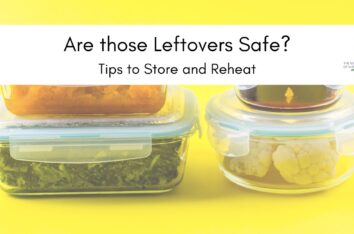Earth Day was this past Saturday April 22, 2023 and while Earth Day is once a year, it’s a reminder that it should be celebrated everyday! One way to support this beautiful planet we live on is through the food we eat. Asking ourselves, “Is it sustainable?” is an increasingly important question being asked when it comes to agriculture and how we eat.

In agriculture, the concept of sustainability is applied toward the production of plant and animal products using farming techniques and practices that help to conserve natural resources with minimal impact on the environment. Sustainable agriculture enables us to produce healthful food without compromising future generations’ ability to do the same.
Sustainable eating is about choosing foods that are healthful to our environment and our bodies. According the 2019 EAT-Lancet commission on healthy diets from sustainable food systems, a global shift toward more plant-based foods would help feed the world’s growing population a nutritious and sustainable diet. This plant-based eating style includes more legumes (beans, peas, lentils, peanuts), whole grains, vegetables, fruits and nuts, and less animal-based foods, especially red meat and processed meat. Limiting refined grains and added sugars is encouraged as well. Here are 7 tips to help you eat more sustainably to fuel yourself and the planet!
7 Tips for Sustainable Eating
Unless you’re a farmer, the best way to support sustainable farming is to eat sustainably. Below are some tips to get you started.
1. Grow Something
It could be herbs in a pot, tomatoes on a patio or a small plot in your yard. Not much gives you a greater appreciation for what it takes to create food than to grow your own. The process can help you gain an understanding of the factors involved in making plants thrive, the attention needed to successfully grow food and how precarious the process can be. Those insights may influence how you buy, use and dispose of food.
2. Shop Locally
Shopping locally is a fun way to support your community. It keeps your dollars in the community in which you live and can help foster a healthy environment of diversity. When you purchase foods that were grown locally, it cuts down on the amount of fuel needed to ship the food to your market.
3. Invite conversations about food
Talk with the farmers at your market, personnel at your grocery store and restaurateurs, or the growing number of people who are paying attention to how foods get on their plates. You can discover new tips, learn about new resources and find more local, sustainably-minded food producers and providers.
4. Eat seasonally
Blueberries don’t grow in Montana during January, yet you can still buy them “fresh” at this time. This means they’re likely coming from far, far away. When possible, focus on foods that are available in season where you live and you’ll be supporting sustainability.
5. Tap your tap
Liquids can be heavy items to ship around the country and lots of fossil fuel is needed to tote them. Instead of purchasing bottled beverages, use a refillable bottle and fill it with water from the tap or filter.
6. Rethink your grocery list
Opt for foods in bulk, more minimally processed foods and more plant-based meals. These choices often require less packaging, waste, energy and water to produce them.
7. Vote with your wallet and fork
There’s no better way to affect the direction of our food system and what grocers, restaurateurs and food companies produce and sell than to influence their bottom line. Ask your food providers to support local farmers, local producers and sustainable agriculture. Show support through your buying decisions.
Contributors: Sarah Klemm, RDN, CD, LDN this article has been adapted from www.eatright.org



